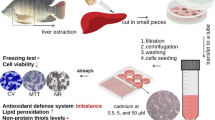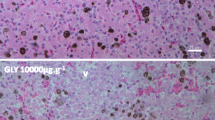Abstract
The present study established a primary hepatocyte culture for the small Indian mongoose (Herpestes auropunctatus). To determine the suitable medium for growing the primary hepatic cells of this species, we compared the condition of cells cultured in three media that are frequently used for mammalian cell culture: Dulbecco’s Modified Eagle’s Medium, RPMI-1640, and William’s E. Of these, William’s E medium was best suited for culturing the hepatic cells of this species. Using periodic acid-Schiff staining and ultrastructural observations, we demonstrated the cells collected from mongoose livers were hepatocytes. To evaluate the distribution of mercury (Hg) in the liver tissue, we carried out autometallography staining. Most of the Hg compounds were found in the central region of hepatic lobules. Smooth endoplasmic reticulum, which plays a role inxenobiotic metabolism, lipid/cholesterol metabolism, and the digestion and detoxification of lipophilic substances is grown in this area. This suggested that Hg colocalized with smooth endoplasmic reticulum. The results of the present study could be useful to identify the detoxification systems of wildlife with high Hg content in the body, and to evaluate the susceptibility of wildlife to Hg toxicity.






Similar content being viewed by others

References
Aoi T, Higuchi T, Kidokoro R, Fukumura R, Yagi A, Ohguchi S, Sasa A, Hayashi H, Sakamoto N, Hanaichi T (1985) An association of mercury with selenium in inorganic mercury intoxication. Hum Toxicol 4:637–642
Arai T, Ikemoto T, Hokura A, Terada Y, Kunito T, Tanabe S, Nakai I (2004) Chemical forms of mercury and cadmium accumulated in marine mammals and seabirds as determined by XAFS analysis. Environ Sci Technol 38:6468–6474
Blévin P, Carravieri A, Jaeger A, Chastel O, Bustamante P, Cherel Y (2013) Wide range of mercury contamination in chicks of southern ocean seabirds. PLoS One 8(1):1–11
Cardellicchio N, Dectaldo A, Di Leo A, Misino A (2002) Accumulation and tissue distribution of mercury and selenium in striped dolphins (Stenella coeruleoalba) from the Mediterranean Sea (southern Italy). Environ Pollut 116:265–271
Cardellichio N, Giandomenico S, Ragone P, Di Leo A (2000) Tissue distribution of metals in striped dolphines (Stenella coeruleoalba) from the Apulian coasts, Southern Italy. Mar Environ Res 49:55–66
Caurant F, Navarro M, Amiard JC (1996) Mercury in pilot whale: possible limits to the detoxification process. Sci Total Environ 186:95–104
Chang TT, Hughes-Fulford M (2014) Molecular mechanisms underlying the enhanced functions of three-dimentional hepatocyte agregates. Biomaterials 35:2162–2171
Chen MH, Shih CC, Chou CL (2002) Mercury, organic-mercury and selenium in small cetaceans in Taiwanese waters. Mar Pollut Bull 45:237–245
Danscher G, Stoltenberg M (2006) Autometallography (AMG) Silver enhancement of quantam dots resulting from (1) metabolism of toxic metals in animals and humans, (2) in vivo, in vitro and immersion created zinc–sulphur/zinc–selenium nanocrystals, (3) metal ions liberated from metal implants and particles. Prog Histochem Cytochem 41:57–139
Das K, Siebert U, Gillet A, Dupont A, Dipoï C, Fonfara S, Mazzucchelli G, Pauw ED, Paue-Gillet MCD (2008) Mercury immune toxicity in hourbor seals: links to in vitro toxicity. Environ. Health 7:52
Decataldo A, Di Leo A, Giandomenico S, Cardellicchio N (2004) Association of metals (mercury, cadmium and zinc) with metallothionein-like proteins in storage organs of stranded dolphins from the Mediterranean sea (Southern Italy). J Environ Monit 6:361–367
Dufresne MM, Frouin H, Pillet S, Lesage V, Guise SD, Fournier M (2010) Comparative sensitivity of harbour and grey seals to several environmental contaminants using in vitro exposure. Mar Pollut Bull 60:344–349
Endo T, Haraguchi K, Sakata M (2002) Mercury and selenium concentrations in the internal organs of toothed whales and dolphins marketed for human consumptions in Japan. Sci Total Environ 300:15–22
Environmenal Protection Agency (US) (1997) Mercury study report to Congress. Environmental Protection Agency (US) Summary Vol 1, Washington
Fant ML, Nyman M, Helle E, Rudbäck E (2001) Mercury, cadmium, lead and selenium in ringed seals (Phoca hispida) from the Baltic Sea and from Svalbard. Environ Pollut 111:493–501
Frouin H, Loseto LL, Stern GA, Haulena M, Ross PS (2012) Mercury toxicity in beluga whale lymphocytes: limited effects of selenium protection. Aquat Toxicol 109:185–193
Gailer J, George GN, Pickering IJ, Madden S, Prince RC, Yu EY, Denton MB, Younis HS, Aposhian HV (2000) Structural basis of the antagonism between inorganic mercury and selenium in mammals. Chem Res Toxicol 13(11):1135–1142
Hasgekar N, Beck JP, Dunkelberg H, Hirsch-Ernst KI, Gebel TW (2006) Influence of antimonite, selenite, and mercury on the toxicity of arsenite in primary rat hepatocytes. Biol Trace Elem Res 111:167–183
Horai S, Minagawa M, Ozaki H, Watanabe I, Takeda Y, Yamada K, Ando T, Akiba S, Abe S, Kuno K (2006) Accumulation of Hg and other heavy metals in the Javan mongoose (Herpestes javanicus) captured on Amamioshima Island, Japan. Chemosphere 65:657–665
Horai S, Furukawa T, Ando T, Akiba S, Takeda Y, Yamada K, Kuno K, Abe S, Watanabe I (2008) Subcellular distribution and potential detoxification mechanisms of mercury in the liver of the Javan mongoose (Herpestes javanicus) in Amamioshima Island. Jpn Environ Toxicol Chem 27(6):1354–1360
Ikemoto T, Kunito T, Tanaka H, Baba N, Miyazaki N, Tanabe S (2004a) Detoxification mechanism of heavy metals in marine mammals and seabirds: interaction of selenium with mercury, silver, copper, zinc, and cadmium in liver. Arch Environ Contam Toxicol 47:402–413
Ikemoto T, Kunito T, Watanabe I, Yasunaga G, Baba N, Miyazaki N, Petrov EA, Tanabe S (2004b) Comparison of trace element accumulation in Baikal seals (Pusa sibirica), Caspian seal (Pusa caspica) and northern fur seals (Callorhinus ursinus). Environ Pollut 127:83–97
Ishibashi O, Nishijima T, Sumida K, Yamashita K, Sudo K, Ogura G, Sunagawa K, Nakada T (2009) Chemical immobilization of the small asian mongoose using anesthetic medicine. Jpn J Zoo Wildl Med 14(2):115–118 (in Japanese)
Karagas MR, Choi AL, Oken E, Horvat M, Schoeny R, Kamai E, Cowell W, Grandjean P, Korrick S (2012) Evidence on the human health effects of low-level methylmercury exposure. Environ. Health Persp 120(6):799–806
Koeman JH, Peeters WHM, Koudstaal-Hol CHM, Tjioe PS, de Goeij JJM (1973) Mercury–selenium correlations in marine mammals. Nature 254:385–386
Komatsu Y, Nakao M, Uezato T, Nakao T (1975) The action of methylmercury on the cell membranes. I. Permeability of methylmercury across the cell membranes in direct comparison with mercury chloride. Ind Health 13:211–219
Krabbenhoft DP, Sunderland EM (2013) Global change and mercury. Science 341:1457–1458
Lemes M, Wang F, Stern GA, Ostertag SK, Chan HM (2011) Methylmercury and selenium speciation in different tissues of beluga whales (Delphinapterusl eucas) from the Western Canadian Arctic. Environ Toxicol Chem 30:2732–2738
Lindberg S, Bullock R, Ebinghaus R, Engstrom D, Feng X, Fitzgerald W, Pirrone N, Prestbo E, Signeur C (2007) A synthesis of progress and uncertainties in attributing the sources of mercury in deposition. Ambio 36:19–32
Mason R, Choi AL, Fitzgerald WF, Hammerschmidt CR, Lamborg CH, Soerensen AL, Sunderland EM (2012) Mercury biogeochemical cycling in the ocean and policy implications. Environ Res 119:101–117
Meador JP, Ernest D, Hohn AA, Tibury K, Gorzelany J, Worthy G, Stein JE (1999) Comparison of elements in bottlenose dolphins stranded on the beaches of Texas and Florida in the gulf of Mexico over a one-year period. Arch Environ Contam Toxicol 36:87–98
Miyazaki M, Namba M (1992) Cell culture and its application primary culture of human hepatocytes and its application. Jpn J Cancer Chemother 19(9):1411–1419
Monteiro-Neto C, Itavo RV, de Souza Moraes LE (2003) Concentrations of heavy metals in Sotalia fluviatilis (Cetacea: Delphinidae) off the coast of Ceará, northeast Brazil. Environ Pollut 123:319–324
Naganuma A, Imura N (1981) Properties of mercury and selenium in a high-molecular weight substance in rabbit tissues formed by simultaneous administration. Pharmacol Biochem Behav 15(3):449–454
Ng PS, Li H, Matsumoto K, Yamazaki S, Kogure T, Tagai T, Nagasawa H (2001) Striped dolphin detoxificates mercury as insoluble Hg(S, Se) in the liver. Proc. Japan Acad 77 Ser. B: 178-183
Rigét F, Braune B, Bignert A, Wilson S, Aars J, Born E, Dam M, Dietz R, Evans M, Evans T, Gamberg M, Gantner N, Green N, Gunnlaugsdóttir H, Kannan K, Letcher R, Muir D, Roach P, Sonne C, Stern G, Wiig Ø (2011) Temporal trends of Hg in Arctic biota, an update. Sci Total Environ 409:3520–3526
Sashi N, Aleo MD, Strock CJ, Stedman DB, Wang H, Will Y (2013) Toxicity assessments of nonsteroidal anti-inflammatory drugs in isoated mitochondoria, rat hepatocytes, and zebrafish show good concordance across chemical classes. Toxicol Appl Pharm 272:272–280
Sato J, Miyazaki M (1984) Primary culture—liver tissue. In Uchida T, Oishi M, Furusawa M, (eds) Dobutsusaiboriyojitsuyokamanyual, Rialaizu-sya, Tokyo, pp134-150, 454
Seigneur C, Vijayaraghavan K, Lohman K, Karamchandani P, Scott C (2004) Global source attribution for mercury deposition in the United States. Environ Sci Technol 38:555–569
Sonne C, Letcher R, Leifsson PS, Rigét F, Bechshøft TØ, Bossi R, Asmund G, Dietz R (2012) Temporal monitoring of liver and kidney lesions in contaminated East Green land polar bears (Ursus maritimus) during 1999–2010. Environ Int 48:143–149
Stoltenberg M, Danscher G (2000) Histochemical differentiation of autometallographically traceable metals (Au, Ag, Hg, Bi, Zn): protocols for chemical removal of separate autometallographic metal clusters in Epon sections. Histochem J 32:645–652
Toyama T, Shinkai Y, Yasutake A, Uchida K, Yamamoto M, Kumagai Y (2011) Isothiocyanates reduce mercury accumulation via an Nrf2-dependent mechanism during exposure of mice to methylmercury. Environ Health Pers 119:1117–1122
Wagemann R, Trebacz E, Lockhart WL (1998) Methylmercury and total mercury in tissues of arctic marine mammals. Sci Total Environ 218:19–31
Wakui M, Kaneda K (2001) Structure, function and materials of the human body. IV liver, gallbladder, pancreas. Nihonijisinposha, Tokyo, p 69
Watari Y, Nagata J, Funakoshi K (2011) New detection of a 30-year-old population of introduced mongoose Herpestes auropunctatus on Kyushu Island, Japan. Biol Invasions 13:269–276
Wislocki GB (1950) Saliva-insoluble glycoproteins, stained by the periodic acid Schiff procedure, in the placentas of pig, cat, mouse, rat, and man. J Natl Cancer Inst 10:1341
Woshner VM, O’Hara TM, Bratton GR, Suydam RS, Beasley VR (2001) Concentrations and interactions of selected essential and non-essential elements in bowhead and beluga whales of Arctic Alaska. J Wildl Dis 37(4):693–710
Acknowledgments
This work was supported by the Global Environment Research Fund (RF-085 and RF-0908) of the Ministry of the Environment, Japan. This work was also supported by a Grant-in-Aid for Scientific Research for Young Scientists (B) 23710044 provided by the Ministry of Education, Culture Sports, Science, and Technology (MEXT), Japan. This study was also partially supported by the Global Center of Excellence (COE) Program of the Japanese Ministry of Education, Culture, Sports, Science and Technology (MEXT), Japan to Ehime University, Japan. The authors wish to thank Dr. A. Subramanian, Ehime University, Japan for critical reading of the manuscript.
Conflict of interest
The authors declare that they have no conflict of interest.
Author information
Authors and Affiliations
Corresponding author
Electronic supplementary material
Below is the link to the electronic supplementary material.
Rights and permissions
About this article
Cite this article
Horai, S., Yanagi, K., Kaname, T. et al. Establishment of a primary hepatocyte culture from the small Indian mongoose (Herpestes auropunctatus) and distribution of mercury in liver tissue. Ecotoxicology 23, 1681–1689 (2014). https://doi.org/10.1007/s10646-014-1307-6
Accepted:
Published:
Issue Date:
DOI: https://doi.org/10.1007/s10646-014-1307-6



